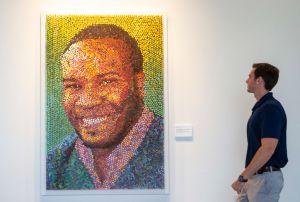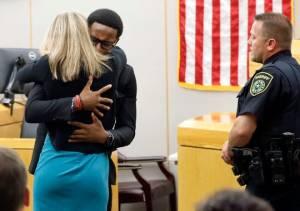
Race and narrative ambiguity
Amber Guyger’s murder trial captured the American public’s attention because it combined the elements of race and narrative ambiguity. These two elements are always present when America argues about criminal justice. Every case Friends of Justice (the organization I direct) has ever tackled is dripping with racial overtones and narrative ambiguity.
By “narrative ambiguity” I simply mean that the facts in a particular case are muddy and open to a wide range of interpretation. Did Amber Guyger really believe she was entering her own apartment? Did the murder of Botham Jean even constitute a crime? Did the murderer truly fear for her life or was that just a convenient fiction conjured to explain the inexplicable?
All of these questions can be answered easily enough, but there is no obvious “right” answer that satisfies everybody.
Few cases in the criminal justice system capture national attention if they don’t touch on the tragic racial history of our nation.
Did the investigation of Mr. Jean’s murder amount to a cover-up?
What would the outcome have been had the case been tried in one of the predominantly white communities to the north of Dallas?
Did Guyger’s failure to retreat at the first signs that a stranger was in her home reflect a secret desire for confrontation and gun play?
How would the system have responded if a black male mistakenly entered the apartment of a white female and gunned her down?
These questions pass through a filter of personal racial experience. There is no single “white” racial experience, of course, nor is there a monolithic “black” emotional response to these things. But who can deny that response to a case like the murder of Botham Jean triggers tends to divide along racial lines?
As a rule, black Americans are far more likely than white Americans to see our criminal justice system as corrupt, fundamentally unjust and radically unfair. The 2010 conviction of Curtis Flowers was overturned by the Supreme Court because the prosecutor worked overtime to keep black residents off the jury. The fact that, in the trial of Amber Guyger, a white police officer was tried by a racially diverse jury likely determined the outcome. The jury that tried the Amber Guyger case reflected the diversity of Dallas, something that almost never happened twenty years ago.
Black observers feared a here-we-go-again scenario in which a white cop gets a slap on the wrist for killing an innocent black man. The victim in this case was relaxing with a bowl of ice cream in his own living room, mundane facts that made the prospect of an unjust outcome particularly unnerving.
That didn’t happen. But the ten-year sentence Guyger received was viewed by many as far too lenient, especially by woke white liberals and black activists. When you consider that people of color are routinely slapped with sentences two or three times that long for non-violent drug crimes, this response is understandable.
We must realize, however, that the United States incarcerates a far higher percentage of its citizens than other western democracies and relatively harsh sentences form a big part of the reason. In 2016, for instance, 655 Americans per 100,000 population were behind bars compared to 146 in England and Wales, 114 in Canada, 73 in Norway and 48 in Japan.
And that’s before we break the statistics down by race. African Americans comprise 12% of the US population, but 40% of our prison population. That means that black citizens are five times as likely as whites to be locked up at any given moment. This comes as a shock to most white people, but black Americans, with few exceptions, are far too well acquainted with the criminal justice system to live in blissful ignorance.
Thankfully, white judicial illiteracy has declined significantly in recent years, largely because young white liberals are much better informed than their un-woke elders, and are often more concerned about racial injustice than most African Americans. According to a recent NPR story, “These days, a large majority of white liberals — nearly 3 in 4 — say discrimination is the main reason black people can’t get ahead.”
The response to this tragedy by Price Waterhouse Cooper, the financial firm that employed Botham Jean, also indicates positive social change. My son-in-law, Norman Lee, is a public artist who was commissioned (with his collaborator, Shane Allbritton) to create a portrait of Mr. Jean to be placed in a room in the PwC building dedicated to Mr. Jean’s memory. The piece includes 10,000 dowel pieces from the victim’s native St. Lucia, each painted a different color.
“We wanted something that we could permanently remember him by,” managing director Scoot Moore said. “This is the part of our building where we want people to feel free to come and gather. And he will always be here with us.”
The portrait’s frame was slightly damaged when it was installed and Norman and I visited the portrait a few days ago to do some simple touch-ups. Being that close to the artwork was personally moving. I am told that when it was unveiled, the same day as the jury verdict came down, people wept openly. Would this have been done for a black employee of a financial firm thirty years ago (had there been any)? I doubt it.
It is frequently argued, of course, that white people, woke or otherwise, have no business talking about black pain or black forgiveness. We can address these realities, but only from a white perspective (which is all I have to offer).
In the world of the tragically un-woke, meanwhile, white and black Americans respond very differently to cases involving a mixture of race and ambiguity.
Religion and race

The theologically educated asked if Brandt Jean’s gesture of forgiveness didn’t amount to “cheap grace”.
The stakes were raised when Judge Tammy Kemp also hugged Guyger, then offered her a Bible complete with whispered reading instructions. Wasn’t this a violation of church and state?
Well yes, technically, it is. In her capacity as a state official Judge Kemp should not be privileging evangelical Christianity or any other form of religion.
But that doesn’t settle the matter. Craig Watkins, the first black Dallas District Attorney in Dallas County who once served as Kemp’s boss, suggested that what is viewed as inappropriate in white-dominated culture might be just fine from a black cultural perspective. “It’s just her Christian nature,” Watkins explained, noting that Kemp always opens meetings with prayer. “You’re having people of color that have the opportunity to make judges now. Their life experience and their religious points of view are different than what we’ve seen in the past. That’s just the evolution of our judicial system.”
It should also be noticed that Kemp and Brandt Jean seemed to view Amber Guyger as a lost soul, a deeply troubled person in desperate need of redemption. More significantly, Guyger responded as if she too saw herself that way. When Brandt was given permission to hug his brother’s murderer she flew into his arms. Every time he began to step away, Amber hugged him closer.
This wasn’t about absolving a murderer of personal responsibility; it was an expression of restorative justice. The goal of restorative justice is to bring offenders to a place where they acknowledge the destructive consequences of their actions and seek to restore relationship with those they have damaged the most.
Sometimes forgiveness is a slow and gradual process; sometimes it’s an instantaneous miracle of grace, a gift to the crime victim whether or not it is accepted by the perpetrator.
It is frequently noted that Brandt Jean and his mother, Allison Jean, responded very differently to the woman who murdered their loved one. Allison’s focus was on the actions of law enforcement and investigators who, she believes, worked overtime to shield the defendant from the consequences of her actions. The crime scene was contaminated, Allison Jean insisted, body cams were conveniently turned off, and the lead investigator opined in public that no actual crime had been committed.
I’d be surprised if Brandt Jean didn’t share these concerns. But they weren’t going to stop him from embracing the woman who murdered his brother. It was something he needed to do because his faith demands it.
Historically, Christians have ignored Jesus’ teaching about enemy-love and radical forgiveness. But these disciplines are central to the kingdom message Jesus proclaimed. Enemy love and radical forgiveness are also prime tenets of the non-violent direct action strategies on display in the civil rights movement of the 1950s and 60s.
Forgiving your enemies and those who “despitefully use you” may seem impossible or even unacceptable, but, for Christian disciples, these disciplines are not optional. And this is true even if, humanly speaking, it is the last thing most of us want to do. For Christians to confuse enemy-love with cheap grace is a category error rooted in theological ignorance.
It is admittedly true that white observers found therapeutic solace in Brandt Jean’s remarkable gesture, as if the weight of collective white guilt had been momentarily lifted. That does constitute cheap grace.
But violators can’t forgive, they can only seek forgiveness. Only victims can forgive. And in so doing they are transformed from victim to victor. We cannot free the violator of personal responsibility, but we, as victims, are freed from the gall of bitterness, hatred and blood lust. That is the victory that overcomes the world.
Amber Guyger as a victim of white pop culture
Much has been made of the nasty texts Guyger shared with her work associates and the memes she posted to social media that celebrate visions of “redemptive violence” and gun culture. (If you’re not familiar with this material you can find a summary here.)
“I wear all black to remind you not to mess with me,” one meme read, “because I’m already dressed for your funeral.” To this was affixed a comment suggesting that Amber already had “a gun, shovel and gloves” in her possession just in case.

Was Amber Guyger immersed in brutal sentiments of this sort, so deeply and for so long, that they skewed her perception when she unwittingly entered her neighbor’s apartment? We can’t know for sure, but I get the impression of a lonely woman, vulnerable and seething with racial resentment, who was drawn to the darker corners of American gun culture due to twisted sort of therapeutic reassurance it provided.
Although I agreed with the prosecution that Ms. Guyger was guilty of murder and deserved serious prison time, I can’t shake the feeling that she is being punished for the sins of her culture. By “her culture” I mean the kind of violent, gun-toting white nationalism that has become a prominent feature of American life.
And if Amber Guyger turned to this culture for solace, reinforcement, and a perverse kind of sustenance, should she be held personally responsible for her actions?
Yes, she should. Guyger certainly deserved to be found guilty and sentenced to significant prison time. She is a violator. She is also a victim. The same is true for the kids who grow up in desperate poverty surrounded by wretched role models. We can’t excuse their behavior when it goes bad, but actions must always be placed in social context.
The Bible, particularly the Hebrew Scriptures, rarely deal in individual guilt and innocence. Israel goes into exile because of her shared or corporate sin. Jesus is Lamb of God that taketh away the sins of the world. The prophets point the finger at nations, not individuals. Jesus laments over Jerusalem, not her individual inhabitants. And in the Bible’s final scenes, destruction falls on Babylon the Great, a corporate entity. It isn’t individual sinners but “death and hell” that are flung into the lake of fire.
Individuals are caught up in the biblical drama, to be sure, and we bear the guilt of our personal sins, but these play out against a backdrop of corporate evil. Sin is a shared reality, a social phenomenon. Isaiah put it best: “I am a man of unclean lips, and I dwell in the midst of a people of unclean lips.”
Amber Guyger, and every other criminal offender, should be viewed as both violator and victim. We must always shoulder a shared responsibility for our place in a culture that churns out such people.
And I believe that Amber Guyger, if only for a brief moment, realized the full extremity of her personal sin and the extent to which she was trapped in a web of social evil. That’s why she ran into the arms of Brandt Jean, a man marked by an amazing grace she had never encountered before. I have the courage to believe she will hang on to Judge Kemp’s Bible (unconstitutional though it may be) and find people who can help her understand what she is reading.
No one can fix what was broken on that awful night. But restorative justice beats vengeance every time.
Gestures of reconciliation, like the hugs offered by Brandt Jean and Judge Tammy Kemp, are desperately needed, not because we’re not so bad after all but because, as individuals and as a culture, we are so hopelessly broken. Violators can’t extend this kind of gesture, only victim-victors are up to the task. So, while I fully appreciate the moral ambiguity surrounding the scene in the courtroom, I’m glad it played out as it did—hugs, unconstitutional Bible and all.
